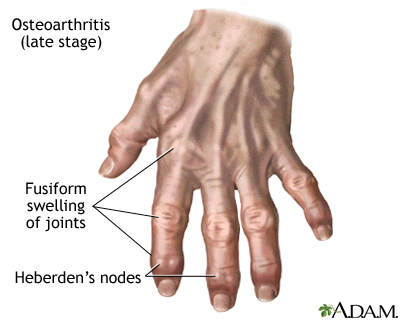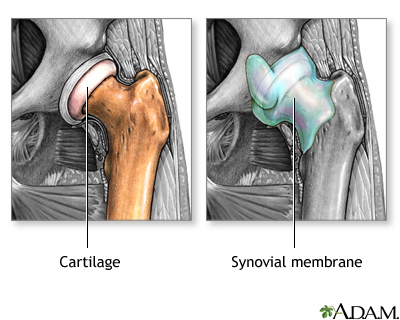Arthritis is inflammation or degeneration of one or more joints. A joint is the area where 2 bones meet. There are more than 100 different types of arthritis.
Causes
Arthritis involves the breakdown of structures of the joint, particularly cartilage. Normal cartilage protects a joint and allows it to move smoothly. Cartilage also absorbs shock when pressure is placed on the joint, such as when you walk. Without the normal amount of cartilage, the bones under the cartilage become damaged and rub together. This causes swelling (inflammation), and stiffness.

Other joint structures affected by arthritis include:
- The synovium
- The bone next to the joint
- Ligaments and tendons
- The linings of the ligaments and tendons (bursae)
Joint inflammation and damage may result from:
- An autoimmune disease (the body's immune system mistakenly attacks healthy tissue)
- Broken bone
- General "wear and tear" on joints
- Infection, most often by bacteria or virus
- Crystals such as uric acid or calcium pyrophosphate dihydrate
In most cases, the joint inflammation goes away after the cause goes away or is treated. Sometimes, it does not. When this happens, you have long-term (chronic) arthritis.
Arthritis may occur in people of any age and sex. Osteoarthritis, which is due to non-inflammatory processes and increases with age, is the most common type.
Other, more common types of inflammatory arthritis include:
- Ankylosing spondylitis
- Crystal arthritis, gout, calcium pyrophosphate deposition disease
- Juvenile rheumatoid arthritis (in children)
- Bacterial infections
- Psoriatic arthritis
- Reactive arthritis
- Rheumatoid arthritis (in adults)
- Scleroderma
- Systemic lupus erythematosus (SLE)

Symptoms
Arthritis causes joint pain, swelling, stiffness, and limited movement. Symptoms can include:
- Joint pain
- Joint swelling
- Reduced ability to move the joint
- Redness and warmth of the skin around a joint
- Joint stiffness, especially in the morning
Exams and Tests
The health care provider will perform a physical exam and ask about your medical history.
The physical exam may show:
- Fluid around a joint
- Warm, red, tender joints
- Difficulty moving a joint (called "limited range of motion")
Some types of arthritis may cause joint deformity. This may be a sign of severe, untreated rheumatoid arthritis.
Blood tests and joint x-rays are often done to check for infection and other causes of arthritis.
The provider may also remove a sample of joint fluid with a needle and send it to a lab to be checked for inflammation crystals or infection.
Treatment
The underlying cause often cannot be cured. The goal of treatment is to:
- Reduce pain and inflammation
- Improve function
- Prevent further joint damage
LIFESTYLE CHANGES
Lifestyle changes are the preferred treatment for osteoarthritis and other types of joint swelling. Exercise can help relieve stiffness, reduce pain and fatigue, and improve muscle and bone strength. Your health e team can help you design an exercise program that is best for you.
Exercise programs may include:
- Low-impact aerobic activity (also called endurance exercise) such as walking
- Range of motion exercises for flexibility
- Strength training for muscle tone
Your provider may suggest physical therapy. This might include:
- Heat or ice.
- Splints or orthotics to support joints and help improve their position. This is often needed for rheumatoid arthritis.
- Water therapy.
- Massage.
Other things you can do include:
- Get plenty of sleep. Sleeping 8 to 10 hours a night and taking naps during the day can help you recover from a flare-up more quickly, and may even help prevent flare-ups.
- Avoid staying in one position for too long.
- Avoid positions or movements that place extra stress on your sore joints.
- Change your home to make activities easier. For example, install grab bars in the shower, the tub, and near the toilet.
- Try stress-reducing activities, such as meditation, yoga, or tai chi.
- Eat a healthy diet full of fruits and vegetables, which contain important vitamins and minerals, especially vitamin E.
- Eat foods rich in omega-3 fatty acids, such as cold-water fish (salmon, mackerel, and herring), flaxseed, rapeseed (canola) oil, soybeans, soybean oil, pumpkin seeds, and walnuts.
- Avoid smoking and excessive alcohol consumption.
- Apply capsaicin cream over your painful joints. You may feel improvement after applying the cream for 3 to 7 days.
- Lose weight, if you are overweight. Weight loss can greatly improve joint pain in the legs and feet.
- Use a cane to reduce pain from hip, knee, ankle, or foot arthritis.
MEDICINES
Medicines may be prescribed along with lifestyle changes. All medicines have some risks. You should be closely followed by a doctor when taking arthritis medicines, even ones you buy over-the-counter.
Over-the-counter medicines:
- Acetaminophen (Tylenol) is often the first medicine tried to reduce pain. Take up to 3,000 a day (2 arthritis-strength Tylenol every 8 hours). To prevent damage to your liver, do not take more than the recommended dose. Since multiple medicines are available without a prescription that also contain acetaminophen, you will need to include them in the 3,000 per day maximum. Also, avoid alcohol when taking acetaminophen.
- Aspirin, ibuprofen, or naproxen are nonsteroidal anti-inflammatory drugs (NSAIDs) that can relieve arthritis pain. However, they can carry risks when used for a long time. Possible side effects include heart attack, stroke, stomach ulcers, bleeding from the digestive tract, and kidney damage.
Depending on the type of arthritis, a number of other medicines may be prescribed:
- Corticosteroids ("steroids") help reduce inflammation. They may be injected into painful joints or given by mouth.
- Disease-modifying anti-rheumatic drugs (DMARDs) are used to treat autoimmune arthritis and SLE
- Biologics and kinase inhibitor are used for the treatment of autoimmune arthritis. They may be given by injection or by mouth.
- For gout, certain medicines to lower uric acid levels may be used.
It is very important to take your medicines as directed by your provider. If you are having problems doing so (for example, because of side effects), you should talk to your provider. Also make sure your provider knows about your all the medicines you are taking, including vitamins and supplements bought without a prescription.
SURGERY AND OTHER TREATMENTS
In some cases, surgery may be done if other treatments have not worked and severe damage to a joint occurs.
This may include:
- Joint replacement, such as a total knee joint replacement
Outlook (Prognosis)
A few arthritis-related disorders can be completely cured with proper treatment. Yet, many of these disorders become long-term (chronic) health problems but can often be well-controlled. Aggressive forms of some arthritic conditions may have significant effects on mobility and may lead to involvement of other body organs or systems.
Possible Complications
Complications of arthritis include:
- Long-term (chronic) pain
- Disability
- Difficulty performing daily activities
When to Contact a Medical Professional
Call your provider if:
- Your joint pain persists beyond 3 days.
- You have severe unexplained joint pain.
- The affected joint is significantly swollen.
- You have a hard time moving the joint.
- Your skin around the joint is red or hot to the touch.
- You have a fever or have lost weight unintentionally.
Prevention
Early diagnosis and treatment can help prevent joint damage. If you have a family history of arthritis, tell your provider, even if you do not have joint pain.
Avoiding excessive, repeated motions may help protect you against osteoarthritis.
Alternative Names
Joint inflammation; Joint degeneration
References
Bykerk VP, Crow MK. Approach to the patient with rheumatic disease. In: Goldman L, Schafer AI, eds. Goldman-Cecil Medicine. 26th ed. Philadelphia, PA: Elsevier; 2020:chap 241.
Inman RD. The spondyloarthropathies. In: Goldman L, Schafer AI, eds. Goldman-Cecil Medicine. 26th ed. Philadelphia, PA: Elsevier; 2020:chap 249.
Kraus VB, Vincent TL. Osteoarthritis. In: Goldman L, Schafer AI, eds. Goldman-Cecil Medicine. 26th ed. Philadelphia, PA: Elsevier; 2020:chap 246.
Mcinnes I, O'Dell JR. Rheumatoid arthritis. In: Goldman L, Schafer AI, eds. Goldman-Cecil Medicine. 26th ed. Philadelphia, PA: Elsevier; 2020:chap 248.
Singh JA, Saag KG, Bridges SL Jr, et al. 2015 American College of Rheumatology guideline for the treatment of rheumatoid arthritis. Arthritis Rheumatol. 2016;68(1):1-26. PMID: 26545940 pubmed.ncbi.nlm.nih.gov/26545940/.
Review Date 10/25/2021
Updated by: Diane M. Horowitz, MD, Rheumatology and Internal Medicine, Northwell Health, Great Neck, NY. Review provided by VeriMed Healthcare Network. Also reviewed by David Zieve, MD, MHA, Medical Director, Brenda Conaway, Editorial Director, and the A.D.A.M. Editorial team.











